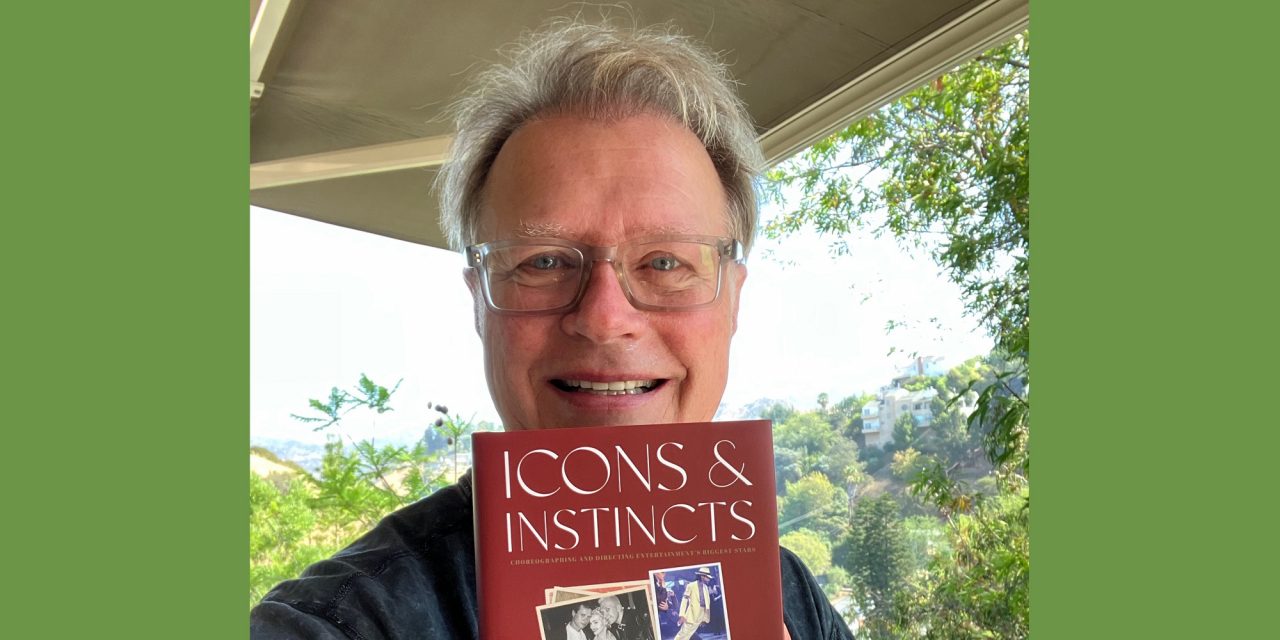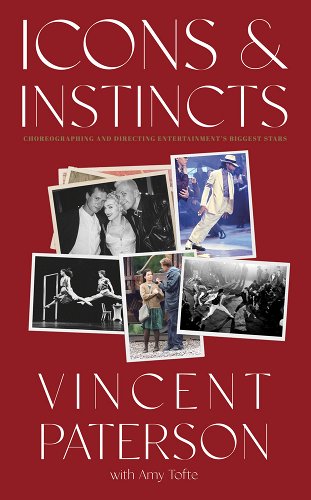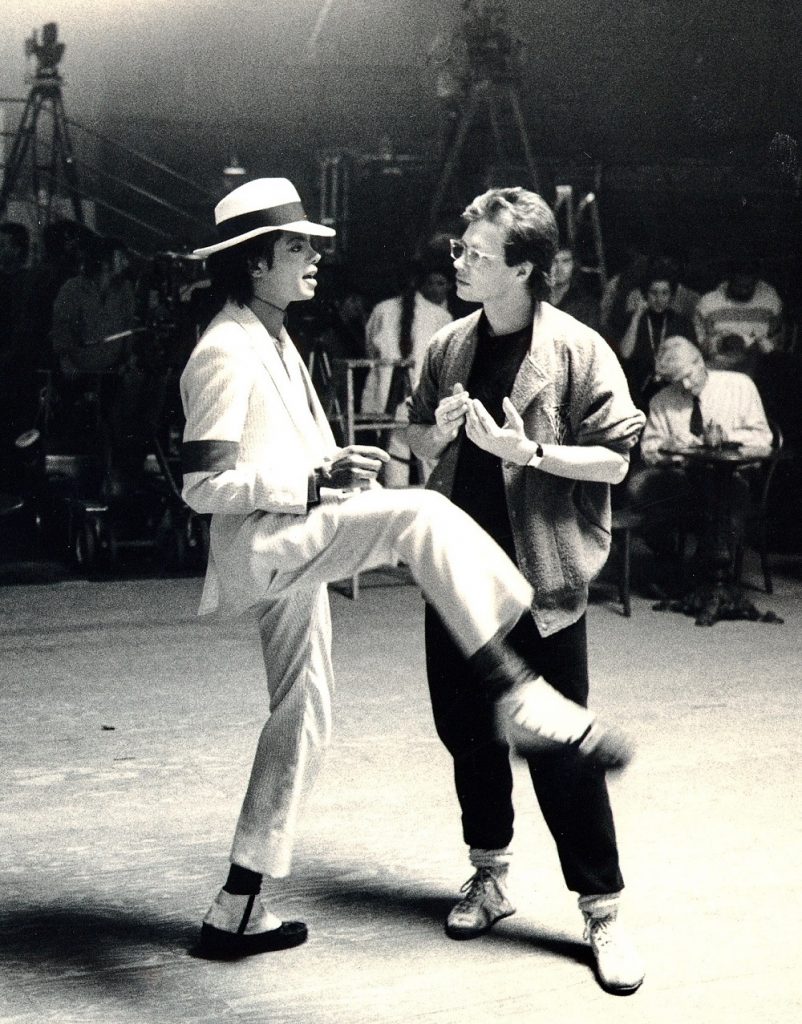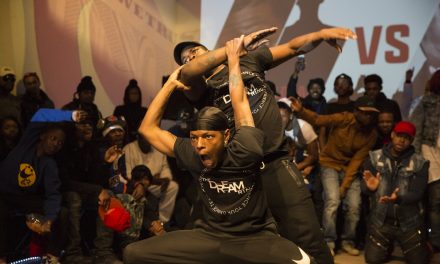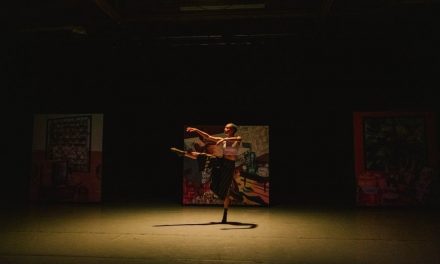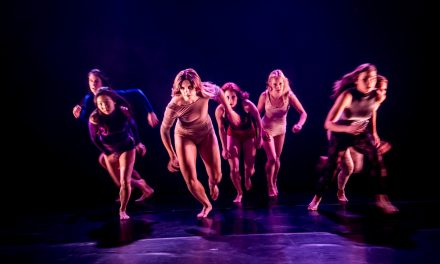Reading internationally acclaimed, Director/Choreographer, Vincent Paterson’s recent book “Icons and Instincts” written with Amy Tofte, was a fascinating surprise. Vincent Paterson has directed and choreographed many of the most important and innovative videos, films and concert works of the 80’s, 90’s and throughout the 2000’s. As a dancer he garnered attention for his performances in “Beat It” and “Thriller” and as director/choreographer he excelled with Michael Jackson’s “Smooth Criminal,” “The Bad Tour,” Madonna’s “Blond Ambition World Tour” and her indelible performance at the MTV Awards. He brought us the Michael Jackson “Lean” and introduced “Vogue” to the world at large. He was the writer director for Cirque du Soleil’s “Viva Elvis” and choreographer for Lars Van Trier’s “Dancer In The Dark.” He created the unforgettable Robin Williams, “Eclectic Celebration Of The Dance” for Director Mike Nichols’ film “The Birdcage.” These and so many more remarkable stories are enough to make the reading of his book an engrossing ride but it is his personal story that will draw you in. His determination to make his way out of a difficult and violent childhood and find his path will serve to inspire the artist in all of us.
This is Part One of a Two Part interview.
TW – Your journey is a little different than most because you didn’t start off as a dancer. You started very late at 24. Your growing up life had not been easy, with a very young mother and a violent and abusive father. Moreover you were not exposed to the arts until college. So, I am curious to have you talk about what compelled you to pursue this career, seeing as the odds were against you.
VP – Well, I really didn’t have a choice. I mean I knew I was an artist, but I didn’t know what that meant exactly. And where I was raised, which was a blue-collar area along the Delaware River filled with oil refineries, there wasn’t really much culture. There was one movie theater, and it was probably about ten miles away and there were no live theaters to go to and no dance schools or anything like that. So dancing never entered my mind but I knew that I was an artist, I just didn’t know what that meant, you know? I had something inside of me that told me I didn’t belong there, that I needed to get out.
Because my home life was so violent and difficult, I found theater in junior high school and high school, and that really gave me the opportunity to take on characters and situations that were so different from my own. It kind of saved me.
TW – Did you have a plan B?
VP –Well, you know, it’s funny. I was speaking to some students recently about a Plan B, because something happened in a presentation they gave. The projector didn’t work and they didn’t have a plan B and it messed up the whole presentation, you know?
TW – Yes, I do know from my own experience.
VP – Anyway when I was young I just raced toward everything that I wanted and because my dad left early and my mom was only 19 years older than me, there was not a lot of discipline in the house. So, I didn’t have anybody to answer to. It was all about taking charge of my life at a very, very young age. I knew that if anything was going to happen, it was only going to happen because of me. No one was going to be able to help me emotionally, physically or financially. My mom was sweet in that she said whatever I wanted to do, she would support it, but she could only support it by saying, “I support you.” Right? In a way, that gives you a lot of freedom because you’re not answering to anybody and you’re making your own place in the world.
When I went to Dickenson College my plan A was to become a lawyer because I was poor and I loved the theater and I thought, if I’m a trial lawyer, then this would work really well. I could get my acting chops going and I would make a lot of money. But when I walked into the Mather’s Theater at Dickinson College that was it. I just knew it wasn’t about law. It had to be about the entertainment world, the theater world. So, my plan A and my plan B just kind of fell apart, crumbled at that time.
But I do have to say that as I have gotten older, I really believe it’s important to have a plan B, and I think that I don’t often have a definitive alternative route but what I do have is, “Homework.” I’m a homework and research freak on every project, because I know I’m not comfortable with improvisation. If I have done the homework and done the research, I’ll have a lot of things in my pocket so when I show up on a set for a commercial and I’m told that what I’ve created isn’t working, or the producers have changed their mind, I’m ready to do something else, it’s not improvisation, it’s being prepared.
TW – Do you think that preparation is an important aspect of being successful in this business as a choreographer? Do you think this has helped you succeed in the long run?
VP – Absolutely, absolutely, in many, many situations. It’s also because I’m insecure; I like to have a plan B or at least to have done a lot of homework so I have a lot of choices available. You know, I used to think for a long time that in the middle of a gig someone was going to tap me on the shoulder and say, “Excuse me, but we got the wrong Vince Paterson.” This was like a recurring nightmare of mine. (laughing)……….
TW – I can relate. (laughing)……..
TW – Having no or little discipline at home can be a benefit in some regards, on the other hand, if you had another kind of personality or interest, you could have gone off the deep end, drugs, alcohol, etc., but you didn’t. Do you think it’s because you have an inner belief in yourself, a sort of steely spine?
VP – I know for me that it was about survival. The combination of knowing that I didn’t belong where I grew up and that there was something, some inner spark that I didn’t understand. Yet it needed to be perceived and executed upon somehow. It took going to college, to kind of get a sense of who I was really and what I was about. And that’s when the artist in me began to emerge.
TW – I know that you were pursuing acting primarily maybe with the intent of directing at some point, I’m not sure you had thought about that yet, but then you fell into the dance world. How did that supersede the acting?
VP – Well, I was living back in Pennsylvania, where I had gone to college and I had the lead in a play by Jean Genet at The Society Hill Playhouse in Philadelphia. I was doing that, and I really thought I would be going into acting and directing somehow. I wasn’t quite sure how, but I was not content. I hated the cold and I hated the East Coast. I had a good friend and she didn’t like the area either. She had a car, so we started traveling and wound up in Tucson. It was January and it was 95 degrees and I was like, Oh my God, this!
I auditioned for theater in Tucson but I hadn’t gotten anything yet and I was working various odd jobs. I passed this little dance studio everyday and one day I went in. I started taking ballet class just because I thought it would keep me in shape. I’d never been an athlete, so I had never really experienced that sense of those endorphins flowing through my body and that high that you get, that natural high, I think that it was like a shot of heroin or something, you know, like, Oh my God, what is this sensation? What is this sensation? I was addicted immediately. I just dropped everything and said, I have no idea why and from what I hear, I’m too old, but this is something that’s calling my name and I don’t have a choice. I just have to follow this for a while.
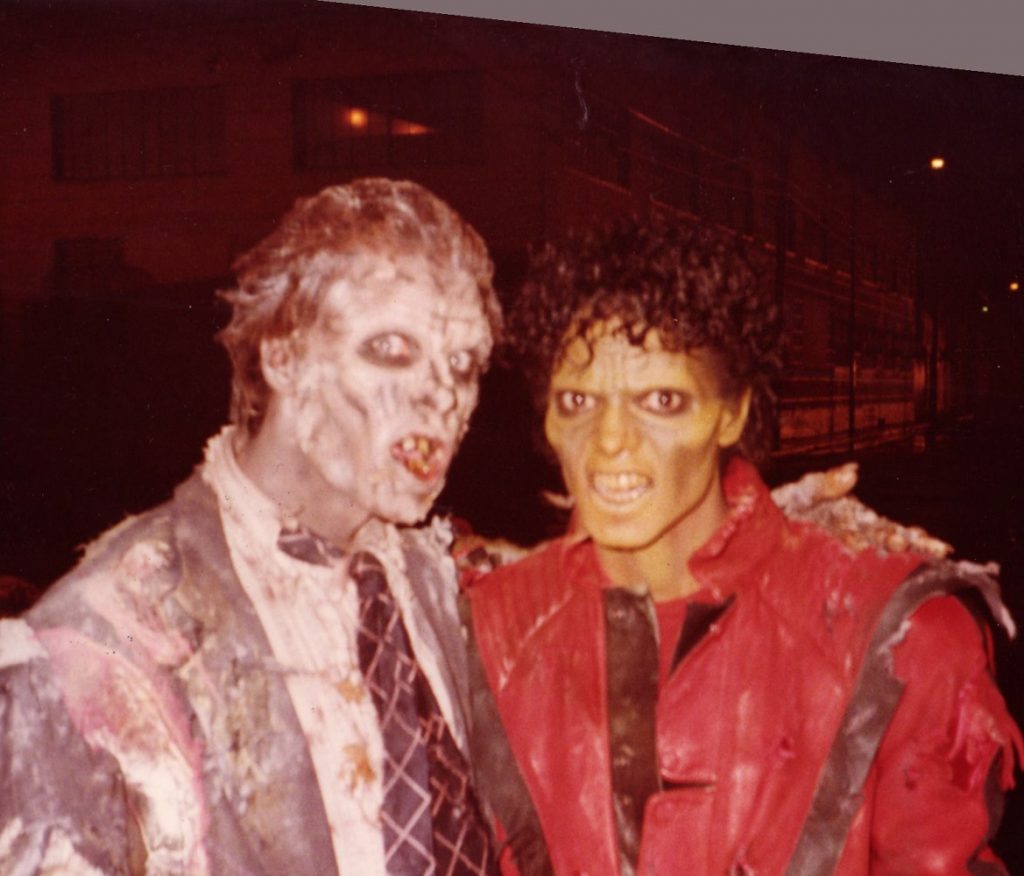
(L-R) Vincent Paterson with Michael Jackson on the set of “Thriller” – Photo courtesy of the artist.
TW – Once, you found dance, you pursued it and you were inspired to move forward in spite of the limitations you mentioned. What do you think it was that compelled you to keep going?
VP – I did certainly have some angels who appeared and gave me a place to stay when I moved to LA, on the floor of their apartment, but I don’t actually know what kept me going. Truly, after nine months of no, no, no, no, no, no, no, no, no, and being down to no money and not eating for a couple of days, another angel took me to a restaurant and I’m thinking, all right, I’m going to apply for a waiter job and I’m going to give this up. Then I went to what I thought was my last dance class and I got a call from choreographer, Joe Bennett. He needed one more male for a TV show he was choreographing; he watched me in that class and he gave me the gig. ……. I got my first dance job.
I always say that if you really want something as strongly as I wanted it you have to believe in yourself. In that moment, had fate not stepped in to say, “no, no, no, you’ve been true to yourself so we’re going to reward you for that” I would have stopped dancing. I think that you have to listen to others as well as your inner voice, that instinctual voice because if you keep banging your head against the wall, you’re only going to get a concussion, right? You can bang your head against the wall a couple of times but then you’ve got to realize, you know, put a little ice on it, maybe you’re supposed to be going down another route. Maybe you need to circumvent what you’ve been doing and take a different path, but not until you’ve exhausted every single possibility to live your dream.
TW – I also think it’s important that people really look at themselves and say, what am I ready for and what am I right for at this time.
VP – Absolutely, but on the other hand, you know, I would beat myself up after not getting commercials. I needed them financially to keep myself going. I always asked myself what am I doing wrong? Why am I not booking any commercials? Thank God I had a friend who was one of the casting directors on a big commercial that I was up for. I was in the final group. It was down to a couple of other guys and me and I didn’t get it. A little while later, I saw her and I said, “Can I ask you about that commercial? I just thought I was so right for it.” She said, “Vincent, you were right for that commercial. Let me tell you what happened. When the principal producers came in, the client said, “he reminds me too much of my ex-boyfriend and I hate my ex-boyfriend!” So, sometimes you have to realize that it’s not really about your talent it’s about other people’s perspectives.
TW – Yes I know, I’ve been on every side of that fence, both as a dancer and then as a choreographer and director. These choices can be so random, just a whim of the producers. Sometimes it goes your way and sometimes it doesn’t. I often had to cut some fantastic dancers because the client wanted a “different” look or whatever.
VP-Yes, I’ve often fought for the talent I wanted on a project when the producers felt differently.
TW – When I started to get work as a choreographer, I had no clue and no interest. I didn’t think I wanted to be a choreographer. I just wanted to be a dancer and I had not really thought about what might be next. As I got a little bit older somehow I fell into assisting a lot of people and then I’d get a little gig of my own here and there, so becoming a choreographer kind of developed organically. At some point the proverbial light bulb went on and I realized these doors were opening for me and maybe I ought to pay attention, maybe this was my path. And I was wondering if you had that sort of moment, when the light went on?
VP – I had finished doing “Beat It” and I got a lot of attention as a dancer. So I started to be invited to be in other music videos with Olivia Newton-John, Diana Ross, Billy Joel, it was really fun, and I liked it, but I always knew that eventually I wanted to be on the other side of the camera. I didn’t want to stay a performer. I always enjoyed directing theatre. I knew I wanted to be the person who assists the actor, who works with the acting and the material, putting it all together and coming out with a result.
Here in L.A. very few people who were dancers ever got to be directors, right? Or got to step onto that choreography path. So I was happily surprised when choreography jobs started to appear with rock stars like Van Halen and David Lee Roth, and that was just from dancing in “Beat It.”
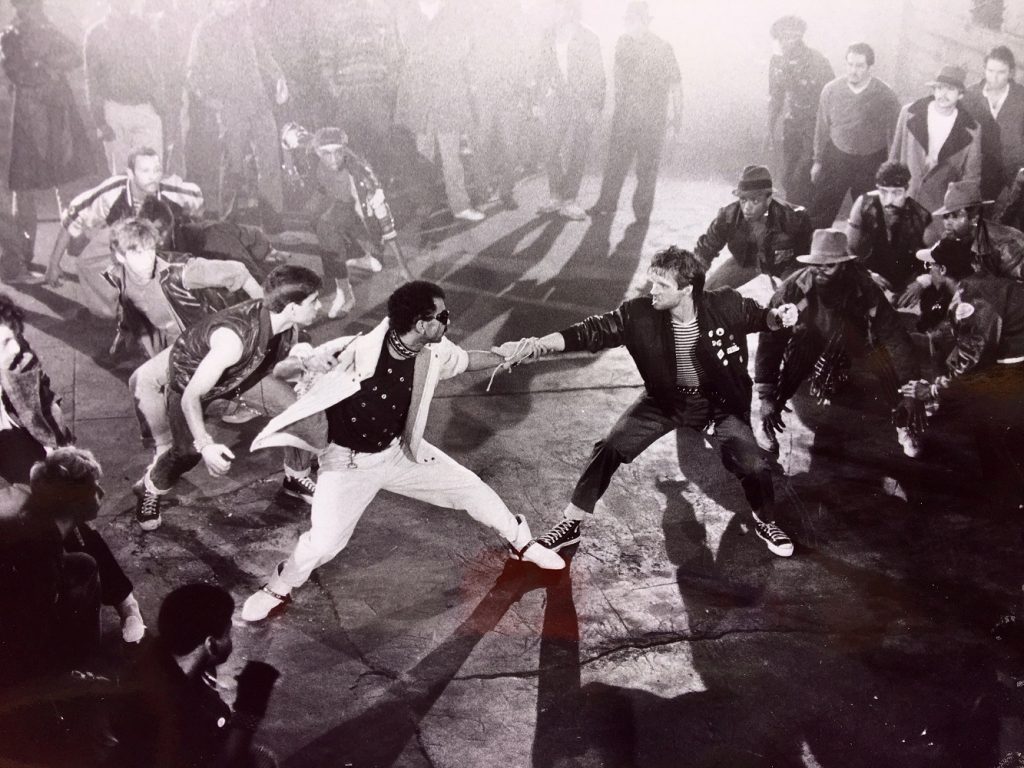
(L-R) Michael Peters, Vincent Paterson in Michael Jackson’s “Beat It” – Photo courtesy of the artist.
TW – Interesting, so maybe that goes to show that the people that were talking to you didn’t understand that you were a dancer and maybe somebody else actually did the steps.
VP – Exactly.
TW – So it created an opportunity for you.
VP – Absolutely. So few people knew about choreography at that point really and they still don’t, to be honest, a lot less at that point anyway.
Things just began to fall into place. I do thank Marine Jahan in my book because, the controversy about her being Jennifer Beals’ body double in “Flashdance” brought her a lot of attention and that led to her getting a gig in Milan to be on a TV show for six weeks. They asked her to bring a choreographer and a dance partner and she asked me to do it. So that really began my choreography career, and I was able to do it far away where nobody saw what I was doing. (Laughing) It was a great, great opportunity and I loved it. After that I started doing less and less dancing and more and more choreography.
TW – Do you think that you also had some foresight knowing that a dance career is finite or do you think it was just your interest?
VP – No, it wasn’t about that, no, it was more about my interests. I wanted to be on the other side. I wanted to be the visionary, more the sculptor than the clay.
TW – Yeah, I understand that.
TW – Slowly but surely, this led to you working with icons Madonna and Michael Jackson, etc. I know those are the obvious names that come up, but there were so many more; Paul McCartney, Donna Summers, Whitney Houston, George Harrison, Sheena Easton, John Travolta and Robin Williams to name a few. It seems in those early jobs that you were allowed an enormous amount of creative freedom. Is that true?
VP – Absolutely it was, with almost everybody. When I started with those small choreography gigs and because of the presence of MTV and being the lead in “Beat It” and “Thriller,” people looked at me like I knew what I was doing. As I said, many people didn’t know what choreographers could do so they gave me free rein because they didn’t know what they needed or wanted. That unknown gave me a lot of freedom.
When I choreographed for Michael Jackson, for instance, he trusted me implicitly. “Smooth Criminal” was my first creation where I wasn’t assistant choreographer to Michael Peters as I had been for “Beat It” and “Thriller.” “Smooth Criminal” was my own from the beginning. Because MJ was still recording his album, I cast it myself and rehearsed it myself and shot the rehearsals. Then I’d meet with him at his house. He’d say, “Oh, I think we need some more people, don’t you?” “Yeah, Mike.” “Oh, I think you need a second floor, don’t you.” “Yeah Mike.” He was always ecstatic about everything. I mean, when he would come into rehearsal before going in with the other dancers, he might ask for small changes like, “Maybe we can put this on this accent,” never much more than that. And the same was true with Madonna. My first big job with Madonna, after I had done “Express Yourself” and the “Pepsi” commercial, was the “Blond Ambition Tour” She was backed against the wall because she had hired another choreographer who had been there, I think, for about a month and hadn’t completed one number. Madonna was understandably panicked and that was to my advantage. When I walked into the room to direct and choreograph the show she knew she didn’t have any option, she had to get this show done. She knew she had made a big mistake, so she said very little and went along with everything I brought to her. I mean, we collaborated with ideas but it was always very positive.
TW – This goes back to the idea of being prepared doesn’t it? After her experience with the other choreographer this must have given her a sense of relief and great confidence in you because you walked in ready to go.
VP – Yes exactly, and we had worked on a couple of things before, so she knew how I worked, so that was really great.
TW – I want to move on to another point. “Smooth Criminal” is just as fabulous today as it ever was. I’m interested, to know about the style you used particularly with the male dancers, the isolations and the hitting of accents so cleanly and interestingly, I love all of that. Not everybody was doing that then, right? How did you find that style?
VP – I think it comes from the acting. I create from character. I’m a narrative choreographer more than someone who creates movement just for the sake of movement. So part of that characterization for me, is watching a celebrity or whomever I’m going to choreograph for, watching how they move naturally. When they start to dance what does their body do? Michael Jackson is not a lyrical dancer. Michael Jackson is a percussive dancer. That’s why I decided to make movement that felt good to me with the music and that would accent the way he moved so that he could step seamlessly from his own improvisation into my choreography with all the other dancers and still have it feel organic.
TW – Exactly, I see that.
VP – That was my decision for making that style of choreography.
TW – Well, it holds up beautifully.
VP – Yes.
TW – Thank you so much Vincent this has been a pleasure. I look forward to “Part Two” and I know the LADC readers will too.
For more information about Vincent Paterson’s autobiography “Icons and Instincts” click HERE.
To view “Vogue” on the MTV Awards Show click HERE.
To view the documentary film “The Man Behind The Throne” click HERE.
Part Two Coming Soon!
Written by Tam Warner for Dance Chronicle.
Featured image: Vincent Paterson with his book “Icons & Instincts” – photo courtesy of the artist

